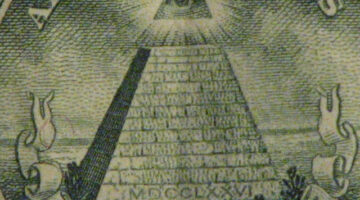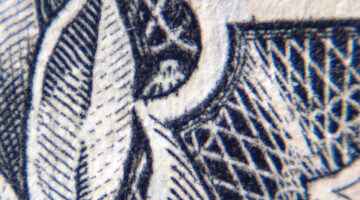Have you ever taken any time to study your money?
Well… pull out a dollar bill from your wallet, purse, or pocket change. Do you notice all of the little symbols on that piece of currency?
Some people say there are secrets on the dollar bill – symbols that convey secret messages.
What are these symbols on the dollar bill and what do they mean?
This is something that I wanted to learn more about.
When I first started collecting coins, I naturally also had a little interest in collecting paper currency as well.
I noticed several things that stood out — like the pyramid with the eyeball. (I remember thinking that was kind of creepy when I was a kid, by the way.)
I also noticed that each dollar bill has a single, large letter on it — printed in black and located inside a circle.
Turns out, those seals (located to the left of the president) are Federal Reserve seal letters.
What Do The Federal Reserve Seals Represent?
The Federal Reserve Bank seal letters are somewhat analogous to mintmarks on coins.
Each of the big black letters on the dollar bill tells you which Federal Reserve bank placed the order for the bill.
Here’s the key:

- A= Boston (1)
- B= New York City (2)
- C= Philadelphia (3)
- D= Cleveland (4)
- E= Richmond, VA (5)
- F= Atlanta (6)
- G= Chicago (7)
- H= St. Louis (8)
- I= Minneapolis (9)
- J= Kansas City (10)
- K= Dallas (11)
- L= San Francisco (12)
Each letter corresponds to the respective number listed above.
Notice how the numbers are in sequence with where the letters are in the alphabet, I.E., A is number 1, B is number 2, and so on? These numbers appear 4 times on the face of the dollar bill.
Why Paper Dollar Bills Don’t Fall Apart
Paper money is made of paper, right?
So, how can it survive for months in circulation and not fall apart when it gets wet?
That’s because paper currency is actually made from a blend of linen and cotton!
Those little red and blue lines that you see on the white areas of your paper money are actually silk fibers interwoven into the material.
Spiders, Owls, & Other Hidden Secrets On Dollar Bills
If you look at your dollar bills closely, you will find what appears to be either a little spider or a tiny owl right near the large “1” at the top right of the dollar bill.
You will see this in the upper-left area of the shield that surrounds the “1.”
This symbol is an accidental occurrence from where the webbed lines vary in the design, and is not intentional.
What Do The Latin Phrases & Roman Numerals Mean?
Annuit Coeptis, which appears above the pyramid, means “God has favored our undertakings.”
Another Latin phrase, Novus Ordo Seclorum, appears below the pyramid and translates to, “New order of the ages.”
E Pluribus Unum will probably look very familiar to you, as the phrase appears on U.S. coins, too. It means, “Out of the many, one” and signifies the union of the 13 original colonies that came together to originally form our nation.
At the base of the pyramid are the Roman numerals MDCCLXXVI, which stand for the year 1776 – the year the Declaration of Independence was signed.
Why Is There A Pyramid On Dollar Bills?

So, what’s up with the pyramid and the eyeball?
The pyramid is a symbol of duration. With its 13 steps (a nod to the 13 colonies that originally formed our nation), it refers to the strength of our country.
The “Eye of Providence” is a visual representation of God looking over our nation — as stated in the phrase Annuit Coeptis.
Why is the pyramid unfinished? It’s symbolic of our nation, which, also, is an unfinished work.
Other Dollar Bill Secrets
Here are a few other fun facts about dollar bills:
- The average dollar bill lasts 18 months in circulation, as compared to a coin, which typically survives about 30 years.
- It currently costs 6 cents to produce a dollar bill. Conversely, a dollar coin costs 10 cents to strike.
- Did you know you can track where your dollar bill has been using its serial numbers? If your dollar bill has been in circulation long enough, you might be able to find it on Where’s George — a website dedicated to tracking where paper currency ends up.







